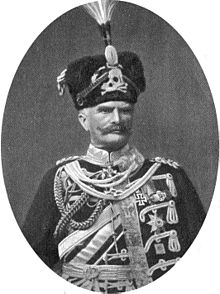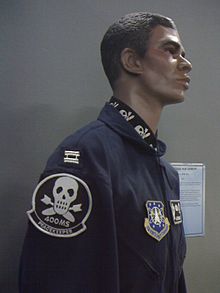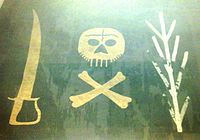- Totenkopf
-
This article is about the military symbol. For the mountain in Germany, see Totenkopf (mountain).
The Totenkopf is the German word for the death's head [1] and an old symbol for death or the dead. It consists usually of the skull and the mandible of the human skeleton. Beyond that it can include two crossed long-bones (femurs).
The German word Totenschädel means literally dead man's skull.
Contents
German Military
Prussia
 August von Mackensen, German field marshal.
August von Mackensen, German field marshal.
Use of the symbol as a military insignia began with the cavalry of the Prussian army under Frederick the Great. Frederick formed Husaren-Regiment Nr. 5 (von Ruesch), a Hussar regiment commanded by Colonel von Ruesch. These Hussars adopted a black uniform with a Totenkopf emblazoned on the front of their mirlitons and wore it on the field in the War of Austrian Succession and in the Seven Years' War.
In 1808, when the regiment was reformed into Leib-Husaren Regiments Nr.1 and Nr.2, the Totenkopf remained a part of the uniform. During the Napoleonic Wars, when Frederick William, Duke of Brunswick-Wolfenbüttel, was killed in battle, his troops changed the colour of their uniforms to black, with a Totenkopf on their shakos in mourning their dead leader (Other sources claim that the "Black Brunswickers" were so equipped while Friedrich Wilhelm of Brunswick lived, as a sign of revenge on the French.[2]
The "death's head" continued to be used throughout the Prussian and Brunswick Armed forces until 1918, and some of the stormtroopers that led the last German offensives on the Western Front in 1918 used Death's Head badges.[3]
Weimar Republic
The Totenkopf was used in Germany throughout the inter-war period, most prominently by the Freikorps. In 1933, it was in use by the regimental staff and the 1st, 5th, and 11th squadrons of the Reichswehr's 5th Cavalry Regiment as a continuation of a tradition from the Kaiserreich.
Third Reich
In the early days of the NSDAP, Julius Schreck, the leader of the Stabswache (Adolf Hitler's bodyguard unit), resurrected the use of the Totenkopf as the unit's insignia. This unit grew into the Schutzstaffel (SS), which continued to use the Totenkopf as insignia throughout its history.
The Totenkopf was also used as the unit insignia of the Panzer forces of the German Heer (Army), and also by the Panzer units of the Luftwaffe, including those of the elite Fallschirm-Panzerdivision HG.[4]
Both the 3rd SS Panzer Division of the Waffen-SS, and the World War II era Luftwaffe's 54th Bomber Wing Kampfgeschwader 54 were given the unit name "Totenkopf", and used virtually the same graphic skull-crossbones insignia as the SS units of the same name.[citation needed]
Non-German Military
 Peacekeeper missile uniform showing a modified Totenkopf circa 1995-2005
Peacekeeper missile uniform showing a modified Totenkopf circa 1995-2005
- The Italian elite storm-troopers of the Arditi used a skull with a dagger between its teeth as a symbol during late 1800 and early 1900.
- The British Army's Queen's Royal Lancers continue to use the skull and crossbones in their emblem, inherited from its use by the 17th Lancers - a unit raised in 1759 following General Wolfe's death in Quebec, with an emblem of a death's head and the words 'Or Glory' chosen in commemoration of him.[5]
- In 1792, a regiment of Hussards de la mort (Death Hussars) was raised to defend the young French Republic from the Austrian attempt to invade France.[6]
- South Korea's 3rd Infantry Division (백골부대) also uses the skull and crossbones in their emblem.
- The primarily Prussian 41st Regiment New York Volunteer Infantry, Mustered in: June 6, 1861-Mustered out: December 9, 1865 wore a death's head insignia.New York Military State Military Museum
- The Portuguese Military Police, the lancers, of the Regimento de Lanceiros 2 use a skull-and-bones image, similar to the totenkopf, in their emblem, itself similar to the one used by the Queen's Royal Lancers.
- The Kingdom of Sweden's Hussar Regiments wore it in the Prussian Style on the front of the Mirleton.
- Ramón Cabrera's regiment adopted in 1838 a skull with crossbones flanked by an olive branch and a sword on a black flag during the Spanish Carlist Wars.
- The White Russian Kornilov regiment adopted it in 1917.
- The Estonian Kuperjanov's Partisan Battalion used the skull and crossbones as their insignia; the Kuperjanov Infantry Battalion continues to use the skull and crossbones as their insignia today.
- Two Polish small cavalry units used death's head emblem during Polish–Ukrainian War and Polish–Soviet War - Dywizjon Jazdy Ochotniczej (also known as Death Hussar) and Poznański Ochotniczy Batalion Śmierci.
- During 1943-1945 the Italian Black Brigades and numerous other forces fighting for the Italian Social Republic, wore various versions of skulls on their uniforms, berets and caps.
- Although not exactly a Totenkopf per se, the Chilean guerrilla leader Manuel Rodriguez used the symbol on his elite forces called "Husares de la muerte" ("Hussars of death").
- United States Marine Corps Reconnaissance Battalions use the skull and crossbones symbol in their emblem.
- DFSW PL (Direct Fire Support Weapons Platoon) of the 3rd Battalion RAR (Royal Australian Regiment) use the same designed Totenkopf of the 3rd SS
- No. 100 Squadron RAF (Royal Air Force) continue to use a flag depicting a skull and crossbones supposedly in reference to a flag stolen from a French brothel in 1918.
Popular culture
- Laibach, during their 2003/2004 WAT tour, used the SS Totenkopf with a bullet hole in the forehead. The defaced symbol is also on the cover of the CD single Tanz Mit Laibach.[7]
- Dr. Totenkopf is the name of the supervillain from the science fiction film Sky Captain and the World of Tomorrow (2004), and was played by Sir Laurence Olivier posthumously, using archived footage and computer graphics.
- In the game Empire Total War, the Death's Head Hussars appears as a special forces unit
- Marilyn Manson combined the Totenkopf insignia with Mickey Mouse's likeness for varied use, leading up to and throughout The Golden Age of Grotesque era.[8]
See also
- Memento Mori
- Skull and crossbones (poison)
- Jolly Roger
- Fascist symbolism
- 3rd SS Division Totenkopf
- SS-Totenkopfverbände
- Kuperjanov Battalion
- Skull and Bones
References
- ^ http://dict.leo.org/ende?lp=ende&lang=de&searchLoc=0&cmpType=relaxed§Hdr=on&spellToler=&search=Totenkopf
- ^ [1]
- ^ First World War - Willmott, H. P.; Dorling Kindersley, 2003, Page 252
- ^ Angolia, John R., and Adolf Schlicht, Uniforms and Traditions of the Luftwaffe Volume 2, R. James Bender Publishing, San Jose CA, 1997. ISBN 0-912138-71-8
- ^ [2]
- ^ (French)http://pagesperso-orange.fr/minismodels/figurines/hussards_de_la_mort/hussards_de_la_mort.htm
- ^ [3]
- ^ http://www.nachtkabarett.com/LogosAndSymbology/RodentDeathsHead
Categories:- Symbols
- Military insignia
Wikimedia Foundation. 2010.






